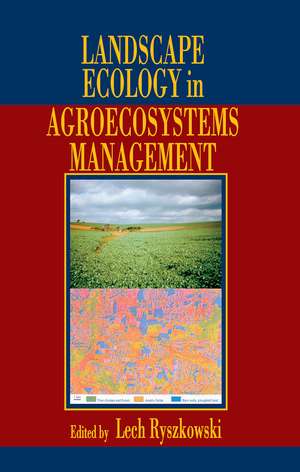Landscape Ecology in Agroecosystems Management
Editat de Lech Ryszkowskien Limba Engleză Paperback – 29 noi 2019
Written by eminent scientists in landscape ecology research, Landscape Ecology in Agroecosystems Management provides a systematic evaluation of the basic ecological functions of the agricultural landscape. It presents a new approach to managing heat balance parameters and evaluates the effectiveness of models for assessing land use changes in rural areas. It also discusses the methods of evaluating matter cycling in agricultural landscapes with emphasis on the process leading to the diffuse pollution problems in ground and surface waters. It reports studies that show how semi-natural habitats maintained in the agricultural landscape constitute important refuge for many plants and animals and thereby enhances biological diversity in farmlands. Finally, it provides guidelines for management of agricultural landscapes for sustainable development of the countryside.
The integration of agriculture and the natural ecosystem in the landscape has recently become a "hot" topic. The review of the achievements in landscape ecology presented in this book clearly demonstrates that landscape ecology is just passing through the threshold between the recognition of various basic processes to being able to manage these processes to achieve
Preț: 352.95 lei
Preț vechi: 454.60 lei
-22% Nou
Puncte Express: 529
Preț estimativ în valută:
67.54€ • 70.66$ • 56.10£
67.54€ • 70.66$ • 56.10£
Carte tipărită la comandă
Livrare economică 02-16 aprilie
Preluare comenzi: 021 569.72.76
Specificații
ISBN-13: 9780367455057
ISBN-10: 0367455056
Pagini: 384
Dimensiuni: 156 x 234 mm
Greutate: 0.52 kg
Ediția:1
Editura: CRC Press
Colecția CRC Press
ISBN-10: 0367455056
Pagini: 384
Dimensiuni: 156 x 234 mm
Greutate: 0.52 kg
Ediția:1
Editura: CRC Press
Colecția CRC Press
Public țintă
Professional Practice & DevelopmentCuprins
The Functional Approach to Agricultural Landscape Analysis. Development of Agriculture and Its Impacts on Landscape Functions. Mitigation of Radiation and Heat Balance Structure by Plant Cover Structure. Water Balance in Agricultural Landscape and Options for its Management by Change in Plant Cover Structure of Landscape. Control of Diffuse Pollution by Mid-Field Shelterbelts and Meadow Strips. Implementation of Riparian Buffer Systems for Landscape Management. Dissolved Organic Substances in Water Bodies of Agricultural Landscape. Influence of Landscape Mosaic Structure on Diversity of Wild Plant and Animal Communities in Agricultural Landscapes of Poland. Field Boundary Habitats for Wildlife, Crop, and Environmental Protection. Changes of Landscape Diversity Patterns in the Province of Wielkopolska, Poland, Under Influence of Agriculture. The Impact of Agriculture on the Environment of the Northern Parisian Basin. Models Assessing the Impact of Land-Use Change in Rural Areas on Development of Environmental Threats and Their Use for Agricultural Politics. Ecological Guidelines for the Management of Afforestations in Rural Areas. Land Units and the Biodiversity of Tree Clumps from Satellite Images to Ground Analysis
Agrolandscape Ecology in the Twenty-First Century. Agriculture and Landscape Ecology.
Agrolandscape Ecology in the Twenty-First Century. Agriculture and Landscape Ecology.
Descriere
Landscape Ecology in Agroecosystems Management provides a systematic evaluation of the basic ecological functions of the agricultural landscape. It presents a new approach to managing heat balance parameters and evaluates the effectiveness of models for assessing land use changes in rural areas. It also discusses the methods of evaluating matter cy
